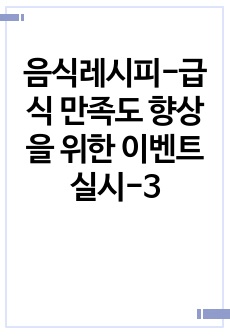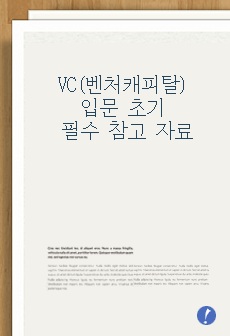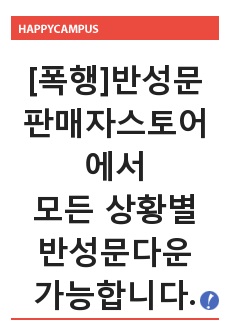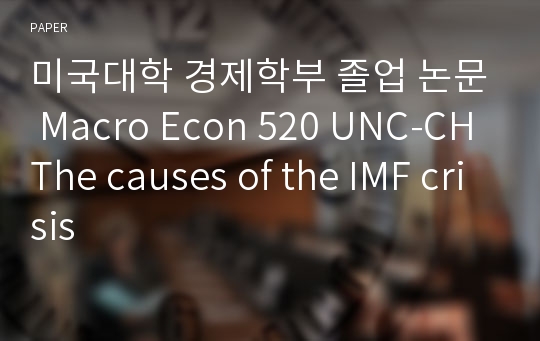미국대학 경제학부 졸업 논문 Macro Econ 520 UNC-CH The causes of the IMF crisis
*주*
다운로드
장바구니
소개글
"미국대학 경제학부 졸업 논문 Macro Econ 520 UNC-CH The causes of the IMF crisis"에 대한 내용입니다.목차
1. Introduction2. Internal Factors
1) Korean Banks’ Structurally Unsound Method of Lending Money
2) The Government-Bank Relationship
3) A Highly Leveraged Corporate Sector
4) The Development of the High-Cost and Low-profit Economy
5) Macroeconomic Developments before the Crisis
6) Policy Mistakes
3. External Factors
1) An Unfriendly International Environment
2) Contagion Effects from Southeast Asia
3) The Appreciation of Japanese Yen
4. Conclusion
5. Appendix 1
6. Appendix 2
7. References
본문내용
On Nov. 1997, Korea faced the IMF crisis, or also known as the financial crisis, which caused severe damage to the Korean economy. The new OECD member was reduced from being the world’s eleventh largest economy to an economy surviving on overnight loans from the international money markets. The won, the Korean currency, fell by more than 50 percent against the US dollar. Also, KOSPI (the Korea Composite Stock Price Index) fell by thirty percent, and the short-term interest rate shot up to forty percent per year. Consequently, on Dec. 1997, Korea called the IMF for rescue, owing $58.3 billion of financial aid. As shown in table 1 and 2 in the appendix 1, Korea had performed continual rapid GDP growth at the rate of 7.8 percent per year in average from 1960 to 1997. Then, what had happened to Korea, and why did the nation have to face the IMF crisis in 1997 all of a sudden? To see what the causes for the crisis were, analyses from six essays of scholars and experts in the field of economics will be introduced and compared.참고 자료
Richards, Anthony, et al. From Crisis to Recovery in Korea: Strategy, Achievements, and Lessons. International Monetary Fund, 2001. Print.This IMF working paper describes three internal factors: the weak financial system, a highly leveraged corporate sector, and macroeconomic developments before the crisis. With tables describing manufacturing debt-equity ratios and percent change in export volume and terms of trade, the paper gives information about the causes in great detail.
Yul, Kwon. “The Korean Financial Crisis Diagnosis, remedies and prospects.” Journal of the Asia Pacific Economy (1998) : 331-357. Print.
Kwon’s journal article addresses four internal factors: the real sector of the Korean economy, the Korean banking sector, the securities market, and the foreign exchange market. What were the problems in those sectors until the time of crisis is fully described in detail.
Harvie, Charles, and Hyun-Hoon Lee. Korea’s Economic Miracle Fading or Reviving? New York: Palgrave Macmillan, 2003. Print.
This book talks about two internal factors and three external factors. The internal factors described in this book are structural weaknesses, and policy mistakes. The external factors are an unfriendly international environment and contagion effects of South-east financial crisis. Furthermore, the book provided me many useful credible tables regarding Korea’s economic performance.
Kim, In-June, and Yeongseop Rhee. “The Korean Currency Crisis and the IMF Program: An Insider’s View.” Seoul Journal of Economics. Print.
Just like in reference [3], this journal article deals with the same internal factors, but it has a different point of view.
Kim, Young-Chan, Doo-Jin Kim, and Young Jun Kim. South Korea: Challenging Globalisation and the Post-Crisis Reforms. Oxford: Chandos Publishing, 2008. Print.
As already discussed in references [3] and [4], this book also talks about an internal factor which is structural weaknesses, but the book has much more details about it.
Kim, Myung Oak, and Sam Jaffe. The New Korea an Inside Look at South Korea’s Economic Rise. New York: AMACOM, 2010. Print.
This book talks about, in my opinion, the most important internal problem that Korea had for the crisis. It is a structurally unsound method of lending money. It is covered in great detail, including why such way of lending money had to occur. Plus, the book talks about one of the external factors: appreciation of Japanese yen.
Krueger, Anne, and Jungho Yoo. “Chaebol Capitalism and the Currency-Financial Crisis in Korea.” University of Chicago Press, 2002. Print.
The journal helped me understand the background of how chaebol capitalism contributed to causing the financial crisis in Korea. Plus, the journal provided me a useful timeline of Korea’s economic events.
Amess, Kevin, and Panicos Demetriades. “Financial Liberalisation and the South Korean Financial Crisis: An Analysis of Expert opinion.” Blackwell Publishing Ltd. 2009. Print.
This essay gave me better understanding about the problems in Korean financial sector: careless loans provided by banks given guarantees by the government. Plus, it provides various interesting points of experts.
Moon, Chulwoo, and Jang-hee Yoo. “Korean financial crisis during 1997-1998 Causes and Challenges.” Ewha Womans University, 1999. Print.
I could accumulate useful information about what really went wrong with Korean corporate sector in terms of chaebols and their unsound way of financing.
Sohn, Chan-Hyun, and Junsok Yang. Korea’s Economic Reform Measures under the IMF Program. Seoul: Korea Institute for International Economic Policy, 1998. Print.
The book describes governmental actions taken involving macroeconomic policies, and restructuring financial and corporate sectors.
Kirk, Donald. Korean Crisis Unraveling of the Miracle in the IMF Era. New York: St. Martin’s Press, 1999. Print.
This book describes the whole story of the IMF crisis starting from the background of the crisis. Then, it describes specific situations went on such as problems occurred by fixed exchange rate system that Korea had before the crisis.
Lee, Jong-wha, and Eduardo Borensztein. “Financial Crisis and Credit Crunch in Korea: Evidence from Firm-Level Data.” International Monetary Fund, 2000. Print.
While the financial crisis was directly exploded by cut off of credit line and recalling short-term debts, the journal provided me from basic knowledge such as defining credit crunch, and what would happen in the financial sector when interest rates rises, to specific financial problems of Korea such as operations of Korean banks’ lending money.


























